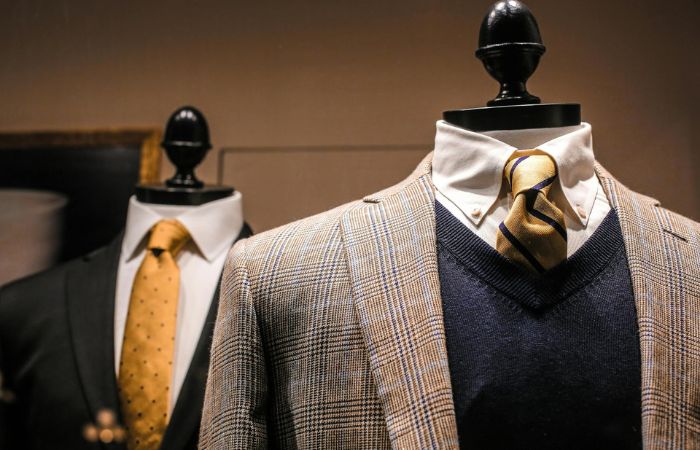What goes into making a high-quality suit? Is it the fabric, the stitches, or perhaps the overall craftsmanship? Or maybe, the answer lies in all three. Suits have been a symbol of elegance and style, yet understanding what elevates one from good to great remains a mystery for many.
Table of Contents
The Fabric Makes the Suit
Fabric is where it all starts. Wool, cotton, linen—each fabric tells its own story. A quality suit often starts with wool. It’s soft, pliable, and durable. Cutting corners with lower-grade fabrics might save you a buck, but it costs you in longevity.
Cotton and linen also have their place in the suit hierarchy. They’re ideal for warmer climates, providing the wearer with breathability. The key lies in choosing fabric that doesn’t just suit the climate but also the occasion.
However, one must also consider the weave of the fabric. A tightly woven material ensures the suit holds its shape while providing the necessary drape. Patterns like herringbone or twill add an understated design element without overwhelming the eye. It’s these subtle decisions that differentiate a high-quality suit from an average one.
The finish of the fabric is another vital aspect. High-twist wool, for example, is not only wrinkle-resistant but also exhibits a sleek appearance, making it favored for work settings. Fabrics blended with silk can add a delicate luster, transforming a simple design into an evening statement piece. The texture and sheen, therefore, play an instrumental role in defining the suit’s purpose and appeal.
When considering options for versatile and classic attire, navy blue suits often come to mind. Their timeless appeal suits both formal and semi-formal occasions, offering a tailored fit that accentuates individual style.
The Stitch in Time
After fabric, the thread takes the stage. A suit that’s stitched well lasts longer. Hand-stitching is the hallmark of quality, showing the craftsman’s dedication to their work.
Look for clean lines and invisible seams. Anything else might be just fast fashion. A quick look at the buttonholes tells you a lot. Are they neatly sewn or quickly done? Quality suits don’t skimp on details.
Beyond aesthetics, stitching also speaks to the suit’s functionality. Reinforced seams ensure the suit withstands the wear and tear of daily life. Skilled tailors may also include extra fabric in strategic areas, allowing for future alterations and extending the garment’s lifetime.
For enthusiasts, the style of stitching can be a point of interest. A saddle stitch, for instance, is known for its strength and is used where reinforcement is necessary. On the other hand, the prick stitch, often adorning lapels, adds a decorative touch while maintaining structural integrity. These techniques showcase both the skill and artistic flair behind a splendid suit.
Fit is King
No matter how expensive the fabric, a poor fit can ruin the ensemble. Off-the-rack suits often disappoint here. Sending your suit to a tailor can change everything.
Bespoke suits, on the other hand, contour perfectly to the body. They follow every curve, providing comfort and style. To invest in a tailor’s expertise is to invest in yourself.
It’s also important to consider how the suit moves with you. The best suits allow for full mobility, ensuring areas such as the shoulders, arms, and torso are not restricted. A quality suit adapts to your frame with grace, offering both form and function.
Additionally, attention to proportion can impact the overall look. For instance, the length of the jacket can visually alter one’s height, while the opening of the trousers can affect the silhouette. Tailors can adjust these proportions, ensuring each suit provides a personalized profile that accentuates the wearer’s physique.
Details, Details, Details
Buttons, lapels, cuffs—the devil is in the details. Mother-of-pearl buttons and carefully padded lapels speak volumes. A keen eye can spot quality from a mile away.
Never underestimate the power of attention to detail. It’s often the little things that make a big impact.
Even the interior lining of a suit tells its own story. The choice of color or pattern can offer a splash of personality hidden beneath the classic exterior. Silk linings, for example, feel smooth against the skin and resist wrinkling, adding both luxury and practicality.
The variety found within details can astonish. Grosgrain ribbons can embellish pockets, providing a textual contrast, while bespoke embroidery inside the jacket adds a personal touch. Moreover, even the orientation of stripes and checks speaks to a suit’s narrative, with each element carefully curated to craft a lasting impression.
The Art of Tailoring
The tailor is the unsung hero of every great suit. They measure, cut, and sew to match the human form precisely. It’s an art, a time-honored tradition, requiring experience and intuition.
Respect the tailor. They are the professionals who take raw fabric and transform it into something extraordinary.
The Price Tag Reflects the Quality
Think a $100 suit will last decades? Think again. Quality comes at a price. It’s an investment, not just a purchase.
High-end suits offer timeless style and unmatched durability. It’s better to have one perfect suit than a hundred mediocre ones. Remember, you get what you pay for.
The Final Takeaway
Crafting a quality suit is a harmonious blend of fabric, stitching, fit, and detail. While instant gratification might steer you to a cheaper option, the wise will opt for lasting elegance and durability.
Understanding what makes a suit exceptional is your first step toward making an informed choice. Because wearing a suit isn’t just about covering your body—it’s about expressing yourself with class.

